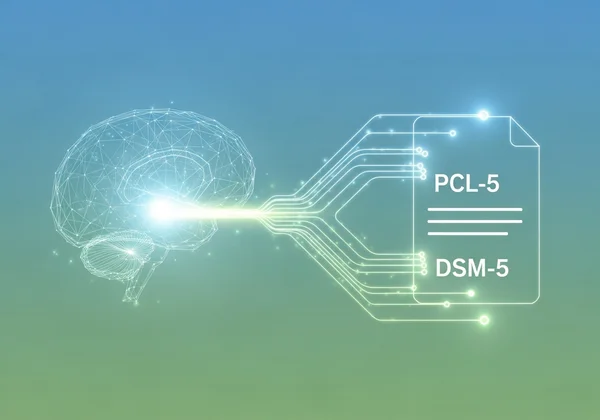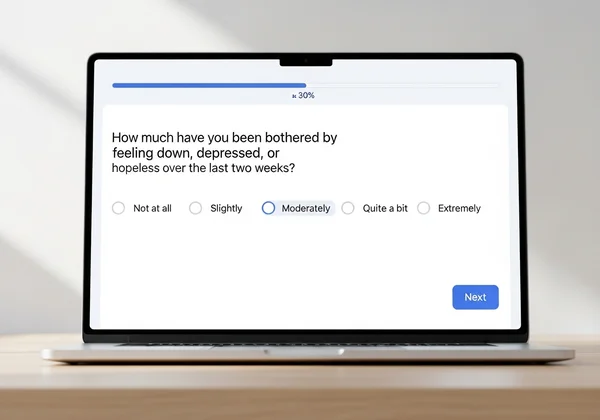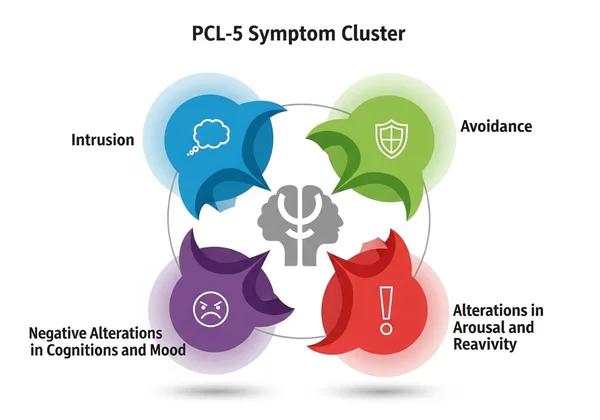The PCL-5: How the Standard PTSD Test Works & Why It Matters
When you’re grappling with difficult experiences, the last thing you need is uncertainty about the resources you turn to for help. You might be considering a PTSD test and asking yourself, "how do I know if I have trauma and if this test is credible?" This is a valid and important question. This guide is here to demystify the PCL-5, the gold standard for PTSD assessment, explaining how it works and why its scientific foundation makes it a trustworthy first step toward understanding your symptoms. Taking a reliable online assessment can be a powerful move towards clarity, and you can start your journey with a confidential tool today.
What is the PCL-5 and Why is it the Standard for PTSD Assessment?
In the world of mental health, accuracy and reliability are paramount. The PCL-5 isn't just another online quiz; it's a clinically respected screening tool used by professionals worldwide. PCL-5 stands for the PTSD Checklist for DSM-5. It was developed by the U.S. Department of Veterans Affairs' National Center for PTSD and is widely recognized as a dependable measure for assessing the symptoms of Post-Traumatic Stress Disorder.
Its strength lies in its direct alignment with the diagnostic criteria laid out in the "Diagnostic and Statistical Manual of Mental Disorders, 5th Edition" (DSM-5), the primary guidebook used by clinicians in the United States. This connection ensures the questions you answer are relevant, comprehensive, and based on decades of psychological research. Using a tool like this gives you a preliminary look into your experiences through the same lens a professional might use.

A Brief History: From DSM-IV to DSM-5 in PTSD Checklist Development
To appreciate the PCL-5, it helps to understand its evolution. The previous version, the PCL, was based on the older DSM-IV criteria. As researchers' understanding of trauma and its effects deepened, the diagnostic criteria for PTSD were updated in the DSM-5. Consequently, the PTSD checklist was revised to create the PCL-5.
This update wasn't just a minor tweak. The PCL-5 includes changes to the number of symptoms, the way they are grouped into clusters, and the wording of the questions to be clearer and more inclusive of different traumatic experiences. This evolution ensures that the assessment remains current with the latest scientific consensus, offering a more precise and relevant screening.
Understanding the PCL-5: Your Reliable PTSD Checklist
At its core, the PCL-5 is a 20-item self-report questionnaire. Each question corresponds to a specific PTSD symptom listed in the DSM-5. You'll rate how much each symptom has bothered you over the past month on a 5-point scale, ranging from "Not at all" to "Extremely."
The design is intentionally straightforward, allowing individuals to complete it without clinical supervision. This makes it an ideal tool for a ptsd self test, providing a private and low-pressure way to explore your symptoms. It empowers you to gather personal insights before deciding whether to seek a formal diagnosis from a healthcare provider.

How the PCL-5 PTSD Test Works: Structure and Scoring for Insight
Understanding the structure of the PCL-5 can help you make sense of your results and see how your experiences fit into the broader picture of PTSD. The test is more than a simple tally of symptoms; it’s designed to identify patterns that are characteristic of post-traumatic stress. This structured approach is a key part of how ptsd tests work effectively.
The process provides a snapshot of your current mental state, which can be invaluable. It transforms vague feelings of distress into structured data, offering a clearer path forward. If you are ready to gain this insight, you can take the free test anytime.
Deciphering the PCL-5 Symptom Clusters and Their Significance
The 20 questions on the PCL-5 are organized into four distinct groups, known as PCL-5 Symptom Clusters. Each cluster represents a core component of the PTSD experience. Understanding them helps you see which aspects of post-traumatic stress may be affecting you most.
-
Criterion B: Intrusion (5 items): These are re-experiencing symptoms, such as unwanted upsetting memories, nightmares, or flashbacks.
-
Criterion C: Avoidance (2 items): This refers to avoiding trauma-related thoughts, feelings, or external reminders like people, places, or situations.
-
Criterion D: Negative Alterations in Cognitions and Mood (7 items): This is the largest cluster, covering symptoms like distorted blame, negative beliefs about oneself or the world, and difficulty experiencing positive emotions.
-
Criterion E: Alterations in Arousal and Reactivity (6 items): These are hyperarousal symptoms, including irritability, hypervigilance, difficulty concentrating, or a heightened startle response.

Interpreting Your PCL-5 Score: What Your Results Mean
After completing the questionnaire, your answers are used to calculate a total severity score, typically ranging from 0 to 80. A higher score generally suggests a greater severity of PTSD symptoms. Clinicians often use a "cut-off" score (commonly 31-33) to indicate that a person's symptoms are significant enough to warrant further clinical assessment.
However, it's crucial to remember that a score is not a diagnosis. It is a piece of information—a starting point. Its true value is in helping you and potentially a professional understand the nature and intensity of your struggles. Our confidential online ptsd test provides you with an immediate score summary and the option for a more detailed AI-powered analysis to help you process what your results might mean for you.
The Power of a PCL-5 Based PTSD Test Online for Your Self-Assessment
Taking a ptsd test online that is based on the PCL-5 offers a unique combination of accessibility and credibility. It brings a professional-grade screening tool directly to you, allowing you to conduct a preliminary self-assessment in a safe and private environment. This is especially important for those who may feel hesitant or unready to speak with someone face-to-face.
An online tool serves as a bridge, helping you organize your thoughts and feelings. It provides a structured way to reflect on your experiences, which can be an empowering first step on a journey toward healing and recovery.
Why Accuracy and Confidentiality Matter in an Online PTSD Test
When seeking answers about your mental health, trust is non-negotiable. That's why the scientific accuracy and confidentiality of an online test are so important. A test based on the PCL-5 is a validated instrument, so you can trust that the questions are relevant and meaningful.
Equally vital is confidentiality. The process of exploring trauma is deeply personal. Our platform ensures your privacy is protected; the test is anonymous, and no personal identifying information is required to receive your results. This creates a secure space where you can be honest with yourself without fear of judgment or exposure.

PCL-5's Role in VA PTSD Tests and Official Screenings
The credibility of the PCL-5 is further cemented by its use in official settings. The Department of Veterans Affairs (VA) uses the PCL-5 extensively as part of its screening process for veterans. For individuals like service members or first responders seeking a VA ptsd test, understanding the PCL-5 is highly relevant.
Knowing that the test you are taking online is the same standard used in formal clinical and institutional screenings can provide significant peace of mind. It confirms that you are not just taking a random quiz but are using a tool that is respected and utilized by professionals in the field.
Taking the First Step: Your Reliable Path to Understanding PTSD
The PCL-5 takes the guesswork out of understanding PTSD symptoms. Far from a mysterious evaluation, it’s a structured, scientifically-supported tool designed to illuminate the impact of trauma. By precisely measuring symptoms against clinical standards, it offers a reliable and insightful starting point for your self-discovery.
Recognizing that you may need support is a sign of strength. Taking a confidential, PCL-5-based online test is a proactive and courageous first step. It can provide the clarity you need to understand your experiences and decide what to do next. If you are ready to gain that insight, take our free PTSD test today.
Frequently Asked Questions About the PCL-5 & Online PTSD Tests
How accurate are online PTSD tests like the PCL-5?
A PCL-5 based online test is highly accurate as a screening tool. Because it uses the same questions and scoring principles as the version used by clinicians, it provides a reliable indicator of symptom severity. However, it cannot provide a formal diagnosis, which requires a comprehensive evaluation by a qualified healthcare professional.
Can I test myself for PTSD using a PCL-5 based tool?
Yes, you can absolutely use a PCL-5 based tool for a self-assessment. That is one of its primary benefits. It’s designed for easy self-administration, allowing you to confidentially check your symptoms against established clinical criteria. You can try our free tool today to get started.
What to do after a PCL-5 based PTSD test?
After taking the test, take a moment to review your results. Our platform provides a summary and an optional AI-driven report for deeper insight. The most important next step, especially if your score indicates significant symptoms, is to consider sharing your results with a doctor or mental health professional. They can provide a formal diagnosis and discuss treatment options.
How do you test for PTSD scientifically?
A scientific test for PTSD, like the PCL-5, is rooted in the DSM-5. It involves systematically measuring the presence and severity of specific symptoms across the four main clusters: intrusion, avoidance, negative changes in mood/thoughts, and arousal/reactivity. This structured approach ensures the assessment is comprehensive and based on the latest psychological research.